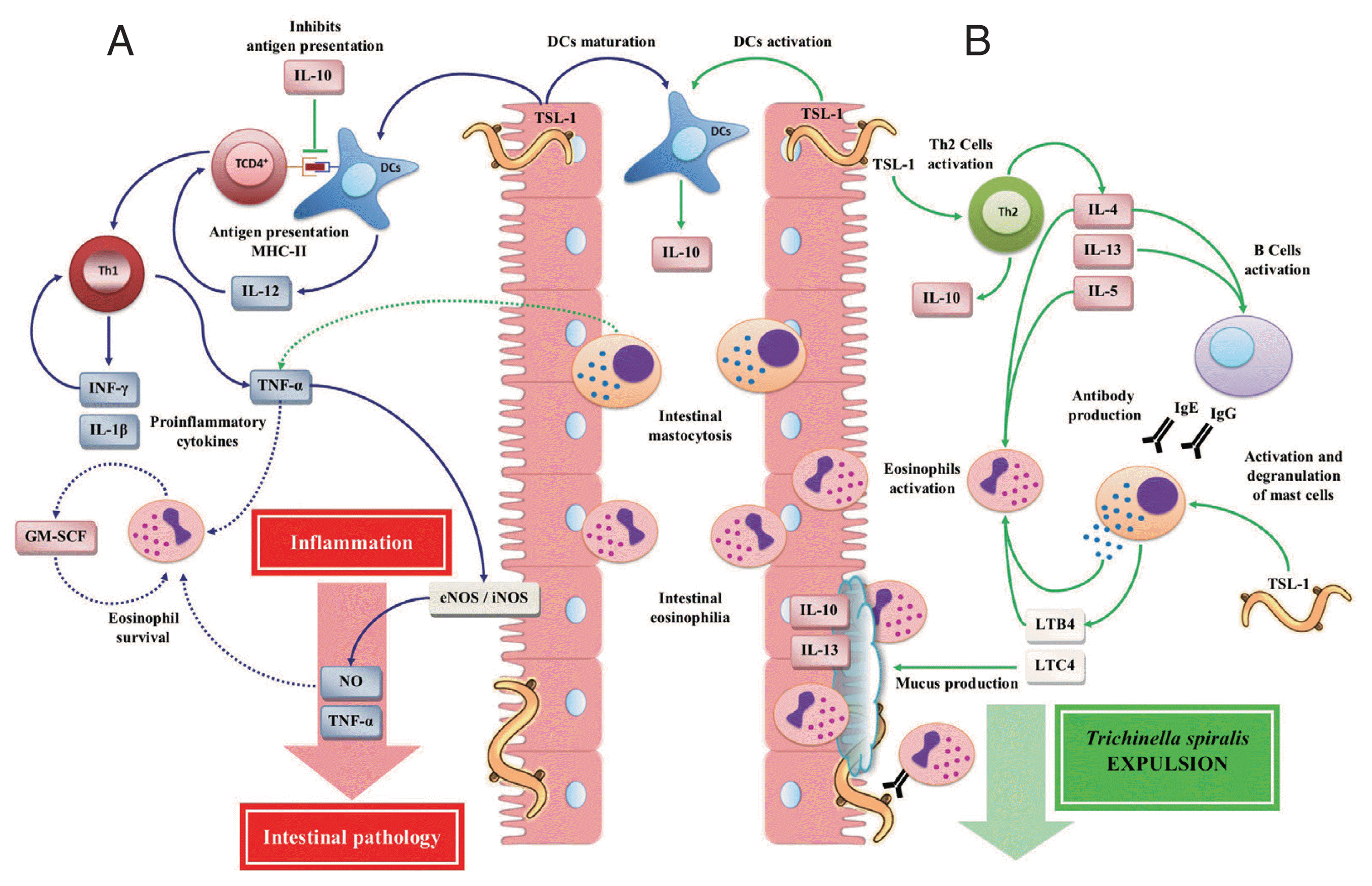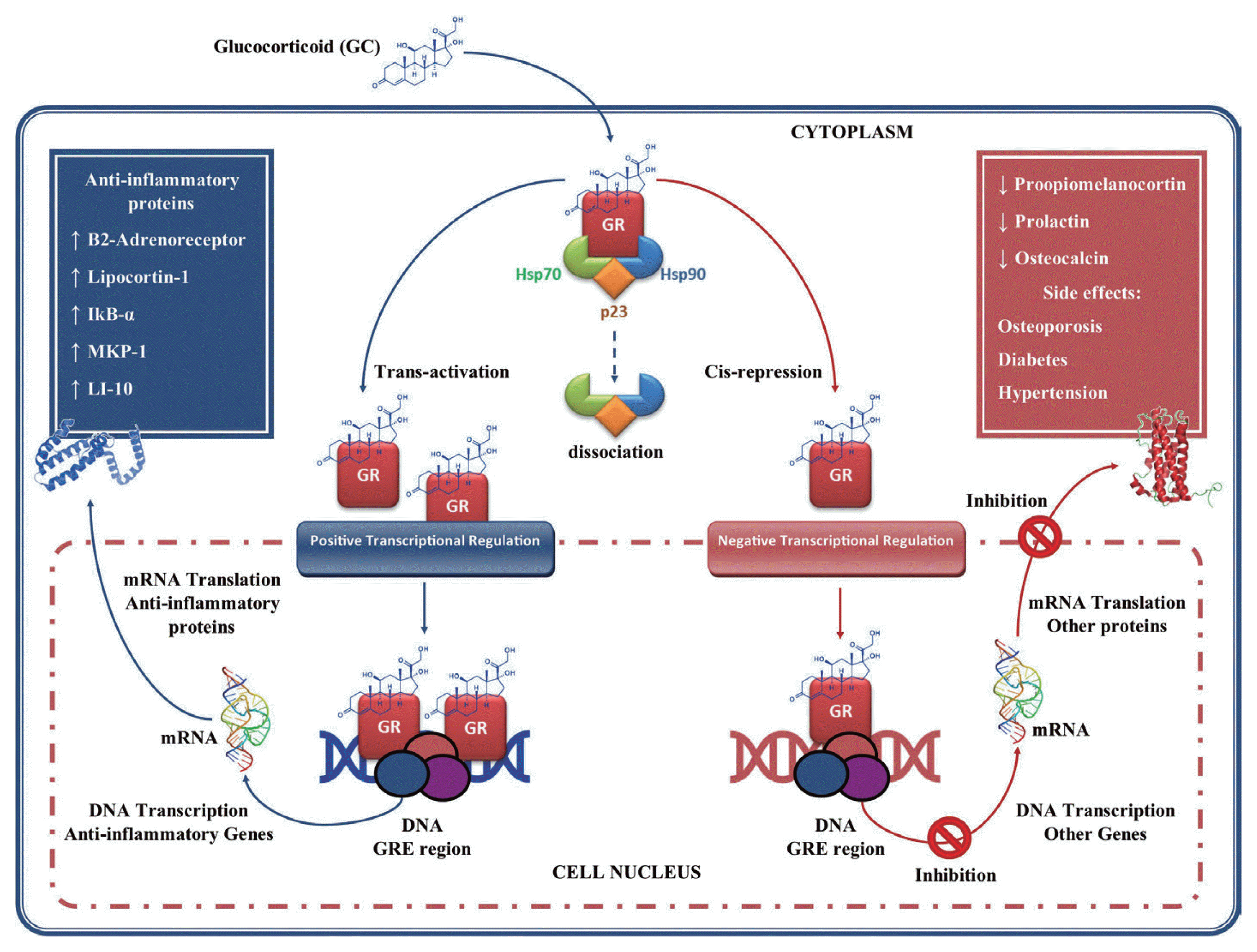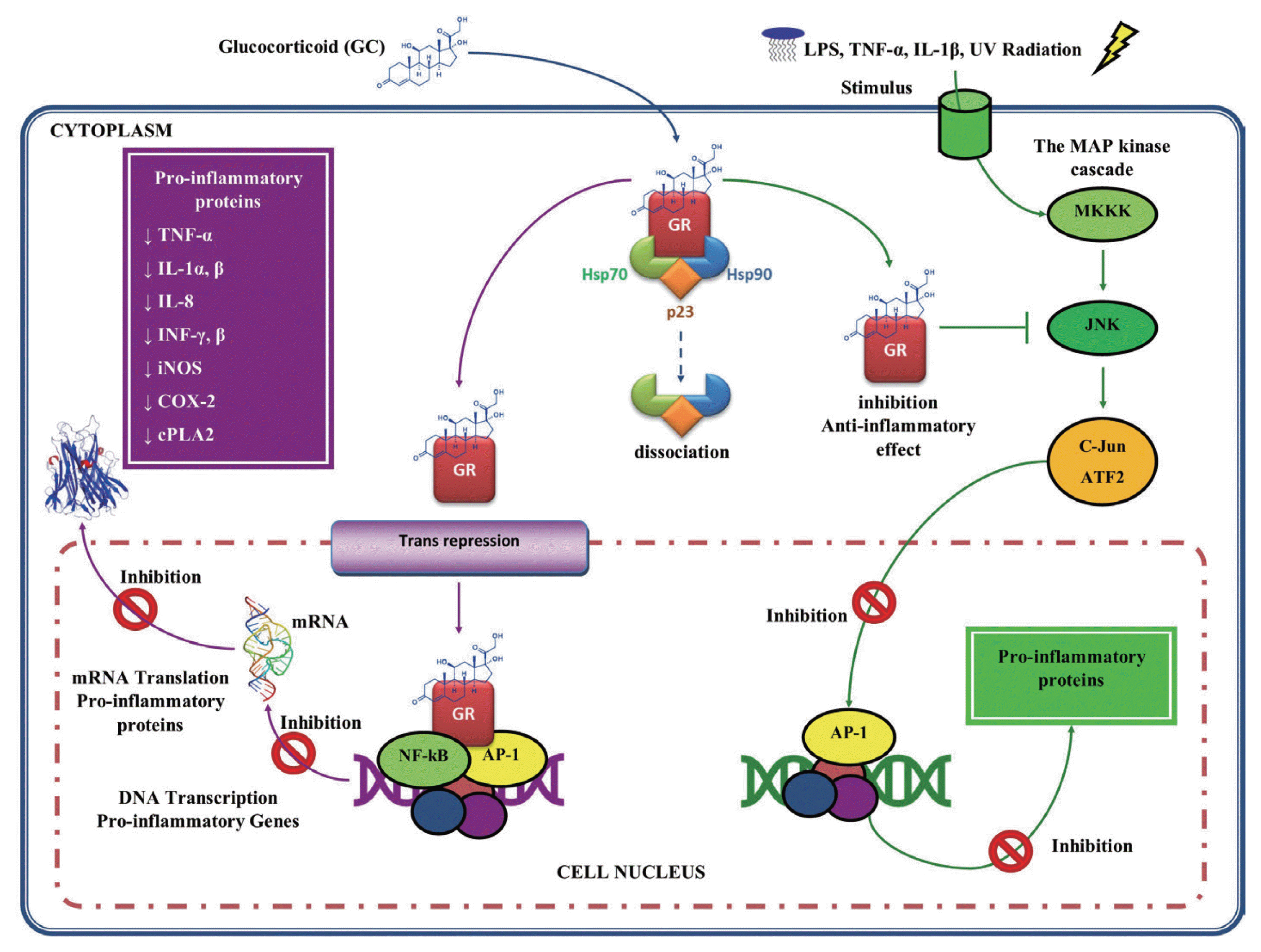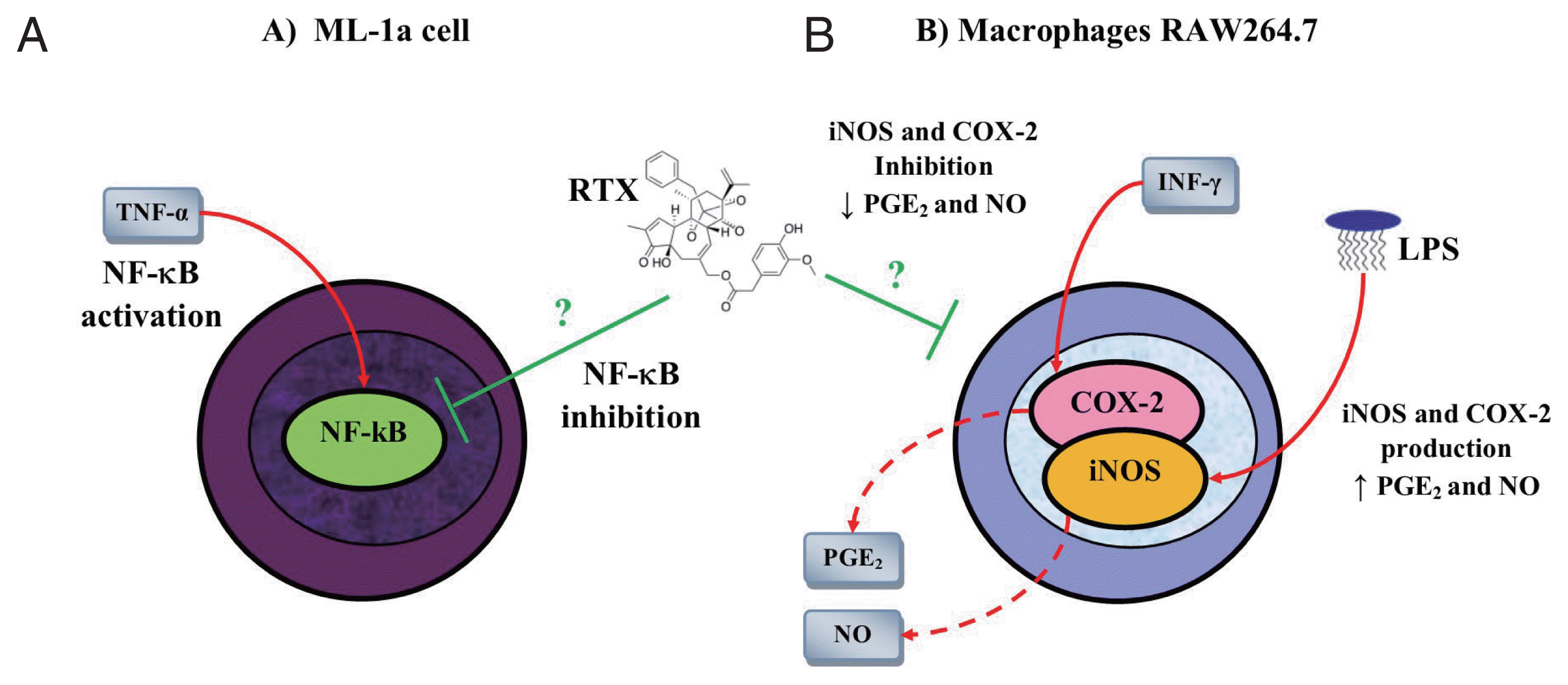1. Grencis RK, Humphreys NE, Bancroft AJ. Immunity to gastrointestinal nematodes: mechanisms and myths.
Immunol Rev 2014;260:183-205.



2. McSorley HJ, Maizels RM. Helminth infections and host immune regulation.
Clin Microbiol Rev 2012;25:585-608.



3. Maizels RM, Hewitson JP, Smith KA. Susceptibility and immunity to helminth parasites.
Curr Opin Immunol 2012;24:459-466.



4. Zaph C, Cooper PJ, Harris NL. Mucosal immune responses following intestinal nematode infection.
Parasite Immunol 2014;36:439-452.



5. Elliott DE, Summers RW, Weinstock JV. Helminths as governors of immune-mediated inflammation.
Int J Parasitol 2007;37:457-464.


6. Maizels RM, Yazdanbakhsh M. Immune regulation by helminth parasites: cellular and molecular mechanisms.
Nat Rev Immunol 2003;3:733-744.


7. Bruschi F, Chiumiento L. Immunomodulation in trichinellosis: does
Trichinella really ecape the host immune system?
Endocr Metab Immune Disord Drug Targets 2012;12:4-15.


8. Laverde LM, Builes LM, Masso CJ. Detección de Trichinella spiralis en cerdos faenados en dos plantas de beneficio en el municipio de bello. Revista CES. Medicina Veterinaria y Zootecnia 2009;4:47-56.
9. Bruschi F. Trichinellosis in developing countries: is it neglected?
J Infect Dev Ctries 2012;6:216-222.


10. Pozio E. World distribution of
Trichinella spp. infections in animals and humans.
Vet Parasitol 2007;149:3-21.


11. Krivokapich SJ, Pozio E, Gatti GM, Prous CL, Ribicich M, Marucci G, La Rosa G, Confalonieri V.
Trichinella patagoniensis n. sp. (Nematoda), a new encapsulated species infecting carnivorous mammals in South America.
Int J Parasitol 2012;42:903-910.


12. Pozio E, Zarlenga DS. New pieces of the
Trichinella puzzle.
Int J Parasitol 2013;43:983-997.


13. Bruschi F, Murrell KD. New aspects of human trichinellosis: the impact of new
Trichinella species.
Postgrad Med J 2002;78:15-22.



14. Murrell KD. The dynamics of
Trichinella spiralis epidemiology: out to pasture?
Vet Parasitol 2016;231:92-96.


15. Theodoropoulos G, Petrakos G.
Trichinella spiralis: differential effect of host bile on the in vitro invasion of infective larvae into epithelial cells.
Exp Parasitol 2010;126:441-444.


16. Moreno García MA, Maldonado Tapia CH, García Mayorga EA, Reveles Hernández RG, Muñoz Escobedo JJ. Fase Intestinal de Trichinella spiralis en modelo murino. Acta biol Colomb 2009;14:203-210 (in Spanish).
17. Moreno AG, Maldonado CT, Chávez Ruvalcaba IR, Reveles RGH, Núñez QZ, Muñoz JJE. El estudio de Trichinella spiralis en modelos experimentales. REDVET 2012;13:1-12.
18. Wu Z, Sofronic-Milosavljevic L, Nagano I, Takahashi Y.
Trichinella spiralis: nurse cell formation with emphasis on analogy to muscle cell repair.
Parasit Vectors 2008;1:1-27.



19. Gruden-Movsesijan A, Ilic N, Colic M, Majstorovic I, Vasilev S, Radovic I, Sofronic-Milosavljevic LJ. The impact of
Trichinella spiralis excretory-secretory products on dendritic cells.
Comp Immunol Microbiol Infect Dis 2011;34:429-439.


20. Ortega-Pierres MG, Yepez-Mulia L, Homan W, Gamble HR, Lim PL, Takahashi Y, Wassom DI, Appleton JA. Workshop on a detailed characterization of
Trichinella spiralis antigens: a platform for future studies on antigens and antibodies to this parasite.
Parasite Immunol 1996;6:273-284.

21. Appleton JA, Romaris F. A pivotal role for glycans at the interface between
Trichinella spiralis and its host.
Vet Parasitol 2001;101:249-260.


22. Yépez-Mulia L, Hernández-Bello R, Arizmendi-Puga N, Ortega-Pierres G. Contributions to the study of
Trichinella spiralis TSL-1 antigens in host immunity.
Parasite Immunol 2007;29:661-670.


23. Bolás-Fernandez F, Corral Bezara LD. TSL-1 antigens of
Trichinella: an overview of their potential role in parasite invasion, survival and serodiagnosis of trichinellosis.
Res Vet Sci 2006;81:297-303.


24. Reason AJ, Ellis LA, Appleton JA, Wisnewski N, Grieve RB, Mc-Neil M, Wassom DL, Morris HR, Dell A. Novel tyvelose-containing tri- and tetra-antennary N-glycans in the immunodominant antigens of the intracellular parasite
Trichinella spiralis
.
Glycobiology 1994;5:593-603.

25. Nagano I, Wu Z, Takahashi Y. Functional genes and proteins of
Trichinella spp.
Parasitol Res 2009;104:197-207.


26. Gold AM, Despommier DD, Buck SW. Partial characterization of two antigens secreted by L1 larvae of
Trichinella spiralis
.
Mol Biochem Parasitol 1990;41:187-196.


27. Su XZ, Prestwood AK, McGraw RA. Cloning and expression of complementary DNA encoding an antigen of
Trichinella spiralis
.
Mol Biochem Parasitol 1991;45:331-336.


28. Wu Z, Nagano I, Nakada T, Takahashi Y. Expression of excretory and secretory protein genes of
Trichinella at muscle stage differs before and after cyst formation.
Parasitol Int 2002;51:155-161.


29. Mitreva M, Jasmer DP, Appleton J, Martin J, Dante M, Wylie T, Clifton SW, Waterston RH, McCarter JP. Gene discovery in the adenophorean nematode
Trichinella spiralis: an analysis of transcription from three life cycle stages.
Mol Biochem Parasitol 2004;137:277-291.


30. Zarlenga DS, Gamble HR. Molecular cloning and expression of an immunodominant 53-kDa excretory-secretory antigen from
Trichinella spiralis muscle larvae.
Mol Biochem Parasitol 1990;42:165-174.


31. Zarlenga DS, Gamble HR. Molecular cloning and expression of an immunodominant 53-kDa excretory-secretory antigen from
Trichinella spiralis muscle larvae.
Mol Biochem Parasitol 1995;72:253.


32. Romarís F, Escalante M, Lorenzo S, Bonay P, Gárate T, Leiro J, Ubeira FM. Monoclonal antibodies raised in Btk (xid) mice reveal new antigenic relationships and molecular interactions among gp53 and other
Trichinella glycoproteins.
Mol Biochem Parasitol 2002;125:173-183.


33. Arasu P, Ellis LA, Iglesias R, Ubeira FM, Appleton JA. Molecular analysis of antigens targeted by protective antibodies in rapid expulsion of
Trichinella spiralis
.
Mol Biochem Parasitol 1994;65:201-211.


34. Beiting DP, Gagliardo LF, Hesse M, Bliss SK, Meskill D, Appleton JA. Coordinated control of immunity to muscle stage
Trichinella spiralis by IL-10, regulatory T Cells, and TGF-b.
J Immunol 2007;178:1039-1047.


35. Ilic N, Gruden-Movsesijan A, Sofronic-Milosavljevic L.
Trichinella spiralis: shaping the immune response.
Immunol Res 2012;52:111-119.


36. Ashour DS.
Trichinella spiralis immunomodulation: an interactive multifactorial process.
Expert Rev Clin Immunol 2013;7:669-675.

37. Cieza RJ, Cao AT, Cong Y, Torres AG. Immunomodulation for gastrointestinal infections.
Expert Rev Anti Infect Ther 2012;3:391-400.

38. Koenderman L, Buurman W, Daha MR. The innate immune response.
Immunol Lett 2014;162:95-102.


39. Sher A, Pearce E, Kaye P. Shaping the immune response to parasites: role of dendritic cells.
Curr Opin Immunol 2003;4:421-429.

40. Ilic N, Worthington JJ, Gruden-Movsesijan A, Travis MA, Sofronic-Milosavljevic L, Grencis RK.
Trichinella spiralis antigens prime mixed Th1/Th2 response but do not induce de novo generation of Foxp3? T cells in vitro.
Parasite Immunol 2011;33:572-582.



41. Sofronic-Milosavljevic L, Ilic N, Pinelli E, Gruden-Movsesijan A. Secretory products of Trichinella spiralis muscle larvae and immunomodulation: implication for autoimmune diseases, allergies, and malignancies. J Immunol Res 2015;31:523875.
42. Yu YR, Deng MJ, Lu WW, Jia MZ, Wu W, Qi YF. Systemic cytokine profiles and splenic toll-like receptor expression during
Trichinella spiralis infection.
Exp Parasitol 2013;134:92-101.


43. Gentilini MV, Nuñez GG, Roux ME, Venturiello SM.
Trichinella spiralis infection rapidly induces lung inflammatory response: the lung as the site of helminthocytotoxic activity.
Immunobiology 2011;216:1054-1063.


44. Ilic N, Colic M, Gruden-Movsesijan A, Majstorovic I, Vasilev S, Sofronic-Milosavljevic LJ. Characterization of rat bone marrow dendritic cells initially primed by
Trichinella spiralis antigens.
Parasite Immunol 2008;30:491.


45. Ming L, Peng RY, Zhang L, Zhang CL, Lv P, Wang ZQ, Cui J, Ren HJ. Invasion by
Trichinella spiralis infective larvae affects the levels of inflammatory cytokines in intestinal epithelial cells in vitro.
Exp Parasitol 2016;170:220-226.


46. Teng MW, Bowman EP, McElwee JJ, Smyth MJ, Casanova JL, Cooper AM, Cua DJ. IL-12 and IL-23 cytokines: from discovery to targeted therapies for immune-mediated inflammatory diseases.
Nat Med 2015;21:719-729.


47. BarbuleacuK B. IL-12 and IL-18 differentially regulate the transcriptional activity of the human IFN-γ promoter in primary CD4
+ T lymphocytes.
J Immunol 1998;160:3642-3647.

48. Bogdan C, Schleicher U. Production of interferon-γ by myeloid cells-fact or fancy?
Trends Immunol 2006;27:282-290.


49. Pestka S, Krause CD, Walter MR. Interferons, interferon-like cytokines, and their receptors.
Immunol Rev 2004;202:8-32.


50. Mühl H, Pfeilschifter J. Anti-inflammatory properties of pro-inflammatory interferon-γ.
Int Immunopharmacol 2003;3(9):1247-1255.


51. Neumann B, Emmanuilidis K, Stadler M, Holzmann B. Distinct functions of interferon-gamma for chemokine expression in models of acute lung inflammation.
Immunology 1998;95:512-521.



52. Helmby H, Grencis RK. IFN-γ-independent effects of IL-12 during intestinal nematode infection.
J Immunol 2003;171:3691-3696.


53. Leung L, Cahill CM. TNF-α and neuropathic pain-a review.
J Neuroinflammation 2010;7:27.



54. Horiuchi T, Mitoma H, Harashima SI. Transmembrane TNF-α: structure, function and interaction with anti-TNF agents.
Rheumatology (Oxford) 2010;49:1215-1228.



55. Parameswaran N, Patial S. Tumor necrosis factor-α signaling in macrophages.
Crit Rev Eukaryot Gene Expr 2010;20:87-103.



56. Lawrence CE, Paterson JC, Higgins LM, MacDonald TT, Kennedy MW, Garside P. IL-4-regulated enteropathy in an intestinal nematode infection.
Eur J Immunol 1998;28:2672-2684.


57. Ierna MX, Scales HE, Saunders KL, Lawrence CE. Mast cell production of IL-4 and TNF may be required for protective and pathological responses in gastrointestinal helminth infection.
Mucosal Immunol 2008;1:147-155.


58. Ierna MX, Scales HE, Müller C, Lawrence CE. Transmembrane tumor necrosis factor alpha is required for enteropathy and is sufficient to promote parasite expulsion in gastrointestinal helminth infection.
Infect Immun 2009;77:3879-3885.



59. Bogdan C. Nitric oxide and the immune response.
Nat Immunol 2001;2:907-916.


60. Guzik TJ, Korbut R, Adamek-Guzik T. Nitric oxide and superoxide in inflammation and immune regulation.
J Physiol Pharmacol 2003;54:469-487.

61. Marzocco S, Di Paola R, Serraino I, Sorrentino R, Meli R, Mattaceraso G, Cuzzocrea S, Pinto A, Autore G. Effect of methyl-guanidine in carrageenan-induced acute inflammation in the rats.
Eur J Pharmacol 2004;484:341-350.


62. Wink DA, Hines HB, Cheng RYS, Switzer CH, Flores-Santana W, Vitek MP, Ridnour LA, Colton CA. Nitric oxide and redox mechanisms in the immune response.
J Leukoc Biol 2011;89:873-891.



63. Moncada S, Erusalimsky JD. Does nitric oxide modulate mitochondrial energy generation and apoptosis?
Nat Rev Mol Cell Biol 2002;3:214-220.


64. Andrade MA, Siles-Lucas M, López-Abán J, Nogal-Ruiz JJ, Pérez-Arellano JL, Martínez-Fernández AR, Muro A.
Trichinella: differing effects of antigens from encapsulated and non-encapsulated species on in vitro nitric oxide production.
Vet Parasitol 2007;143:86-90.


65. Lawrence CE, Paterson JC, Wei XQ, Liew FY, Garside P, Kennedy MW. Nitric oxide mediates intestinal pathology but not immune expulsion during
Trichinella spiralis infection in mice.
J Immunol 2000;164:4229-4234.


66. Dinarello CA. Immunological and inflammatory functions of the interleukin-1 family.
Annu Rev Immunol 2009;27:519-550.


67. Garib FY, Rizopulu AP, Kuchmiy AA, Garib VF. Inactivation of inflammasomes by pathogens regulates inflammation.
Biochemistry (Mosc) 2016;81:1326-1339.


68. Muñoz-Carrillo JL, Muñoz-Escobedo JJ, Maldonado-Tapia CH, Chávez-Ruvalcaba F, Moreno-García MA. Resiniferatoxin lowers TNF-α, NO and PGE2 in the intestinal phase and the parasite burden in the muscular phase of T. spiralis infection. Parasite Immunol 2017;39:1-14.
69. Muñoz-Carrillo JL, Contreras-Cordero JF, Muñoz-López JL, Maldonado-Tapia CH, Muñoz-Escobedo JJ, Moreno-García MA. Resiniferatoxin modulates the Th1 immune response and protects the host during intestinal nematode infection.
Parasite Immunol 2017;39:1-16.

70. Sofronic-Milosavljevic LJ, Radovic I, Ilic N, Majstorovic I, Cvetkovic J, Gruden-Movsesijan A. Application of dendritic cells stimulated with
Trichinella spiralis excretory-secretory antigens alleviates experimental autoimmune encephalomyelitis.
Med Microbiol Immunol 2013;202:239-249.


71. Helmby H, Grencis RK. Contrasting roles for IL-10 in protective immunity to different life cycle stages of intestinal nematode parasites.
Eur J Immunol 2003;33:2382-2390.


72. Gurish MF, Bryce PJ, Tao H, Kisselgof AB, Thornton EM, Miller HR, Friend DS, Oettgen HC. IgE enhances parasite clearance and regulates mast cell responses in mice infected with
Trichinella spiralis
.
J Immunol 2004;172:1139-1145.


73. Wang LJ, Cao Y, Shi HN. Helminth infections and intestinal inflammation.
World J Gastroenterol 2008;14:5125-5132.



74. Rogerio AP, Anibal FF. Role of Leukotrienes on Protozoan and Helminth Infections.
Mediators Inflamm 2012;2012:595694.



75. Knight PA, Brown JK, Pemberton AD. Innate immune response mechanisms in the intestinal epithelium: potential roles for mast cells and goblet cells in the expulsion of adult
Trichinella spiralis
.
Parasitology 2008;135:655-670.


76. Akiho H, Ihara E, Motomura Y, Nakamura K. Cytokine-induced alterations of gastrointestinal motility in gastrointestinal disorders.
World J Gastrointest Pathophysiol 2011;2:72-81.



77. Rothenberg ME, Hogan SP. The eosinophil. Annual review of immunology.
Annu Rev Immunol 2006;24:147-174.


78. Bruschi F, Korenaga M, Watanabe N. Eosinophils and
Trichinella infection: toxic for the parasite and the host?
Trends Parasitol 2008;24:462-467.


79. Vallance BA, Mathaei KI, Sanovic S, Young IG, Collins SM. Interleukin-5 deficient mice exhibit impaired host defence against challenge
Trichinella spiralis infections.
Parasite Immunol 2000;22:487-492.


80. Gottstein B, Pozio E, Nöckler K. Epidemiology, diagnosis, treatment, and control of
Trichinellosis
.
Clin Microbiol Rev 2009;22:127-145.



81. Dupouy-Camet J, Kociecka W, Bruschi F, Bolas-Fernandez F, Pozio E. Opinion on the diagnosis and treatment of human trichinellosis.
Expert Opin Pharmacother 2002;3:1117-1130.


82. Shimoni Z, Klein Z, Weiner P, MOccH PFM. The use of prednisone in the treatment of trichinellosis.
Isr Med Assoc J 2007;9:537-539.

83. Oakley RH, Cidlowski JA. Cellular processing of the glucocorticoid receptor gene and protein: new mechanisms for generating tissue-specific actions of glucocorticoids.
J Biol Chem 2011;286:3177-3184.


84. Biddie SC, Conway-Campbell BL, Lightman SL. Dynamic regulation of glucocorticoid signaling in health and disease.
Rheumatology 2012;51:403-412.


85. Nixon M, Upreti R, Andrew R. 5α-Reduced glucocorticoids: a story of natural selection.
J Endocrinol 2012;212:111-127.


86. Serra HA, Roganovich JM, Rizzo LF. Glucocorticoides: paradigma de medicina traslacional. De lo molecular al uso clínico.
Medicina 2012;72:158-170.

87. Charmandari E. Primary generalized glucocorticoid resistance and hypersensitivity.
Horm Res Paediatr 2011;76:145-155.


88. Jeremy Saklatvala. Glucocorticoids: do we know how they work?
Arthritis Res 2002;4:146-150.



89. De Iudicibus S, Franca R, Martelossi S, Ventura A, Decorti G. Molecular mechanism of glucocorticoid resistance in inflammatory bowel disease.
World J Gastroenterol 2011;17:1095-1108.



90. Barnes PJ. Glucocorticosteroids: current and future directions.
Br J Pharmacol 2011;163:29-43.



91. Barnes PJ. How corticosteroids control inflammation.
Br J Pharmacol 2006;148:245-254.



92. Dostert A1, Heinzel T. Negative glucocorticoid receptor response elements and their role in glucocorticoid action.
Curr Pharm Des 2004;10:2807-2816.


93. Belvisi MG. Regulation of inflammatory cell function by corticosteroids.
Proc Am Thorac Soc 2004;1:207-214.


94. Wullaert A, Bonnet MC, Pasparakis M. NF-κB in the regulation of epithelial homeostasis and inflammation.
Cell Res 2011;21:146-158.


95. Ray A, Prefontaine KE. Physical association and functional antagonism between the p65 subunit of transcription factor NF-kappa B and the glucocorticoid receptor.
Proc Natl Acad Sci USA 1994;91:752-756.



96. Scheinman RI, Gualberto A, Jewell CM, Cidlowski JA, Baldwin AS. Characterization of mechanisms involved in transrepression of NF-kappa B by activated glucocorticoid receptors.
Mol Cell Biol 1995;15:943-953.



97. Flammer JR, Rogatsky I. Minireview: Glucocorticoids in autoimmunity: unexpected targets and mechanisms.
Mol Endocrinol 2011;25:1075-1086.



98. Galon J, Franchimont D, Hiroi N, et al. Gene profiling reveals unknown enhancing and suppressive actions of glucocorticoids on immune cells.
FASEB J 2002;16:61-71.


99. Ashwell JD, Lu FW, Vacchio MS. Glucocorticoids in T cell development and function.
Annu Rev Immunol 2000;18:309-345.


100. Lasa M, Brook M, Saklatvala J, Clark AR. Dexamethasone destabilizes cyclooxygenase 2 mRNA by inhibiting mitogen-activated protein kinase p38.
Mol Cell Biol 2001;21:771-780.



101. Lamas AM, Leon OG, Schleimer RP. Glucocorticoids inhibit eosinophil responses to granulocyte-macrophage colony-stimulating factor.
J Immunol 1991;147:254-259.

102. Arai Y, Nakamura Y, Inoue F, Yamamoto K, Saito K, Furusawa S. Glucocorticoid-induced apoptotic pathways in eosinophils: comparison with glucocorticoid-sensitive leukemia cells.
Int J Hematol 2000;71:340-349.

103. Bozic F, Jasarevic A, Marinculic A, Durakovic E, Kozaric Z. Dexamethasone as a modulator of jejunal goblet cells hyperplasia during Trichinella spiralis gut infection of mice. Helminthologia 2000;37:3-8.
104. Alvarado RM, Meza LE, García ME, Saldívar S, Moreno GA. Hormonal effect on the parasite load in the infection by T. spiralis of a murine experimental model. Trichinellosis. 9th International Conference on Trichinellosis (ICT9). In Ortega P, Wakelin eds, 1996. 107-114.
105. Piekarska J, Szczypka M, Michalski A, Obminska-Mrukowicz B, Gorczykowski M. The effect of immunomodulating drugs on the percentage of apoptotic and necrotic lymphocytes in inflammatory infiltrations in the muscle tissue of mice infected with
Trichinella spiralis
.
Pol J Vet Sci 2010;13:233-240.

106. Salazar H, Jara-Oseguera A, Rosenbaum T. El canal TRPV1 como diana para tratar el dolor.
Rev Neurol 2009;48:357-364.

107. Pal M, Angaru S, Kodimuthali A, Dhingra N. Vanilloid receptor antagonists: emerging class of novel anti-inflammatory agents for pain management.
Curr Pharm Des 2009;15:1008-1026.


108. Nilius B, Szallasi A. Transient receptor potential channels as drug targets: from the science of basic research to the art of medicine.
Pharmacol Rev 2014;66:676-814.


109. Carnevale V, Rohacs T. TRPV1: a target for rational drug design.
Pharmaceuticals (Basel) 2016;9:52.


110. Lee YH, Im SA, Kim JW, Lee CK. Vanilloid receptor 1 agonists, capsaicin and resiniferatoxin, enhance MHC class I-restricted viral antigen presentation in virus-infected dendritic cells.
Immune Netw 2016;16:233-241.



111. Singh S, Natarajan K, Aggarwal BB. Capsaicin (8-methyl-N-vanillyl-6-nonenamide) is a potent inhibitor of nuclear transcription factor-kappa B activation by diverse agents.
J Immunol 1996;157:4412-4420.

112. Chen CW, Lee ST, Wu WT, Fu WM, Ho FM, Lin WW. Signal transduction for inhibition of inducible nitric oxide synthase and cyclooxygenase-2 induction by capsaicin and related analogs in macrophages.
Br J Pharmacol 2003;140:1077-1087.



113. Ueda K, Tsuji F, Hirata T. Preventive effect of TRPV1 agonists capsaicin and resiniferatoxin on ischemia/reperfusion-induced renal injury in rats.
J Cardiovasc Pharmacol 2008;51:513-520.


114. Oscar Gutiérrez-Coronado, Muñoz-Carrillo JL, Miranda-Beltrán ML, Pérez-Vega MI, Soria-Fregozo C, Villalobos-Gutiérrez PT. Evaluación de la actividad antiinflamatoria de resiniferatoxina en un modelo murino de inflamación inducido por Lipopolicacárido. Rev Latinoamer Quím 2012;39:287.
115. Levi-Schaffer F, Temkin V, Malamud V, Feld S, Zilberman Y. Mast Cells Enhance Eosinophil Survival In Vitro: Role of TNF-α and Granulocyte-Macrophage Colony-Stimulating.
Factor J Immunol 1998;160:5554-5562.

116. Uings I, Puxeddu I, Temkin V, Smith SJ, Fattah D, Ray KP, Levi-Schaffer F. Effects of dexamethasone on TNF-alpha-induced release of cytokines from purified human blood eosinophils.
Clin Mol Allergy 2005;3:1-5.



117. Hebestreit H, Yousefi S, Balatti I, Weber M, Crameri R, Simon D, Hartung K, Schapowal A, Blaser K, Simon HU. Expression and function of the Fas receptor on human blood and tissue eosinophils.
Eur J Immunol 1996;26:1775-1780.


118. Létuvé S, Druilhe A, Grandsaigne M, Aubier M, Pretolani M. Involvement of caspases and of mitochondria in Fas ligation-induced eosinophil apoptosis: modulation by interleukin-5 and interferon-gamma.
J Leukoc Biol 2001;70:767-775.

119. Hebestreit H, Dibbert B, Balatti I, Braun D, Schapowal A, Blaser K, Simon HU. Disruption of Fas Receptor Signaling by Nitric Oxide in Eosinophils.
J Exp Med 1998;187:415-425.



120. Fabre V, Beiting DP, Bliss SK, Gebreselassie NG, Gagliardo LF, Lee NA, Lee JJ, Appleton JA. Eosinophil deficiency compromises parasite survival in chronic nematode infection.
J Immunol 2009;182:1577-1583.



121. Huang L, Gebreselassie NG, Gagliardo LF, Ruyechan MC, Lee NA, Lee JJ, Appleton JA. Eosinophil-derived IL-10 supports chronic nematode infection.
J Immunol 2014;193:4178-4187.



122. Huang L, Gebreselassie NG, Gagliardo LF, Ruyechan MC, Luber KL, Lee NA, Lee JJ, Appleton JA. Eosinophils mediate protective immunity against secondary nematode infection.
J Immunol 2015;194:283-290.


123. Huang L, Beiting DP, Gebreselassie NG, Gagliardo LF, Ruyechan MC, Lee NA, Lee JJ, Appleton JA. Eosinophils and IL-4 support nematode growth coincident with an innate response to tissue injury.
PLoS Pathog 2015;11:1-17.








